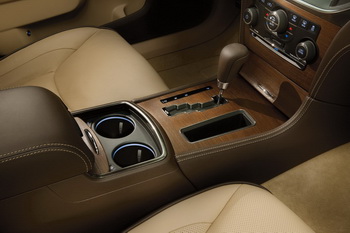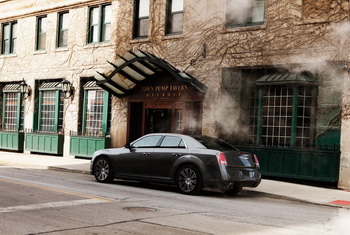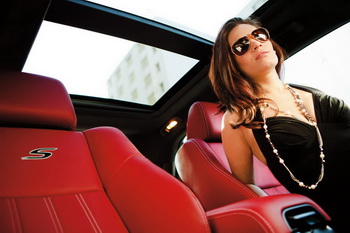|
|


 |
|
Chrysler is to
expand the recently facelifted 300 sedan's
range by offering the niche 300 Executive
(top and middle) and the 300S (bottom). The
official press image of the 300S (bottom)
perhaps quite accurately points to the
positioning of the 300 sedan, with its gaudy
reputation for being the 'limo' of choice
for less tasteful 'hen parties'. |
|
 |
|
|
|
At the New York Auto Show
this week the Chrysler brand is previewing an expansion
of the lineup of its recently facelifted flagship 300
sedan with new higher performance and luxury versions
which aim to help the full size model recapture the
wider appeal of the original.
The higher performance offering being added to the 300
range is the SRT8 version, which hopes to leverage the
well-known sports nametag. However it still has the
dated HEMI engine under the bonnet which in its new size
of 6.4 litres still leads to less that class topping
performance with Chrysler saying it "estimates 465
horsepower and 465 lb/ft of torque". Meanwhile in an
attempt to appeal to younger, more urban-centric
customers - as the brand currently finds most of its
customers in the 50s age group - Chrysler will roll out
the cosmetically-enhanced 300S series. This 300 version
features 20-inch aluminum wheels with black painted
pockets, sport-tuned suspension, a premium audio, black
exterior accents and a monotone black or exclusive black
with 'Radar Red' interior environment. There are however
no performance upgrades to match its sporty pretentions.
“We’re bringing three new and distinct models to our 300
lineup in 2012 with the 300 SRT8, 300S Series and 300C
Executive Series, each designed with specific consumer
lifestyles in mind,” said Chrysler CEO Olivier François.
“More than an icon of simple American motoring, the
Chrysler 300 is an icon of attainable style and
performance. For those customers who live for the sport
of being first, the all-new Chrysler 300 SRT8 is the no
compromises king of the hill, featuring the ultimate
combination of world-class luxury and performance in our
most powerful, best-handling sedan ever.”
The Street and Racing Technology (SRT) performance
engineering team has built what Chrysler claims is its
most powerful and best handling model ever, strong
ambitions from a project that appears from the first
glance to have very contained objectives. Projected
performance numbers include 0-60 mph acceleration in the
high 4-second range; quarter mile in high 12 second
range; 0-100-0 mph in less than 16 seconds, top speed of
175 mph and stopping power from 60-0 mph in 120 feet.
Owners of any Chrysler Group SRT vehicle also receive
one day of professional driving instruction from the
Richard Petty Racing School as part of the SRT Track
Experience, designed to maximize their driving knowledge
and skills on the street or track. Sessions are held
throughout the year at selected tracks.
The return of the 300 SRT8 to the Chrysler lineup in
2012 - Chrysler believes - evokes comparison to the
original high-performance production car of its time –
the 1955 Chrysler 300. Known for simple, strong lines,
excellent engineering, high levels of luxury and
outstanding performance with the first modern American
V-8 engine to produce 300 horsepower, the first Chrysler
300 (C-300) was styled by Virgil Exner, who radically
redesigned the entire Chrysler line and created what
they called "The Forward Look" in 1955. Without much
chrome on the sides, his designs were simple, but
strong. Exner is credited with creating the illusion of
fast, forward movement. The Chrysler C-300 won on both
the road course and the “flying mile” at Daytona in
1955. In 1956, the Chrysler 300B model won both events
again. In fact, the Chrysler 300s dominated NASCAR
competition in 1955 and 1956, taking the overall
championship in both years. A legendary and luxurious
performance car was born. The “letter cars” quickly
became the most desirable of the Chrysler lineup and
became known as the “Beautiful Brutes.”
Under the hood of the 300 SRT8, the new 6.4-liter HEMI
V8 makes its debut in the Chrysler brand product lineup
delivering 465 horsepower and 465 lb-ft of torque for
this capacity of engine, figures that don't standout
from the crowd and comfortably undershoot other brands
that use large capacity engines, such as Mercedes-Benz.
It is up 40 horsepower and 45 lb/ft up over the
6.1-liter HEMI V8 it replaces meaning that there has
been only a very slight performance improvement achieved
along the way. The outdated HEMI V8 design, which
features previous-generation technology such as SOHC and
two values per cylinder, is reportedly cheaper to build
than the new Pentastar V6 but can be sold for a
significant premium.
The improved torque output - including an additional 80
lbft at 2,900 rpm - Chrysler says, allows for improved
standing starts and improved straight-line performance
while new, performance-tuned motor mounts improve idle
stability and ride control at any speed. An active
intake manifold and high-lift camshaft with cam phasing
provides maximum low-end torque while optimizing
high-end power. Even with the slightly elevated power
numbers, an estimated 25-percent fuel economy increase
on the highway is achieved by use of a new for 2012
active valve exhaust system that allows the standard
Fuel Saver technology (four-cylinder mode) to engage
over a wider rpm range. The new active exhaust system
also allows for straight-through mid and rear mufflers
for a throaty exhaust note under engine load. Specific
fuel economy numbers - says Chrysler - will be announced
closer to the vehicle introduction, implying that
economy will be nothing to write home about.
Standard steering wheel-mounted paddle shifters join the
standard Auto Stick on the floor console. Unfortunately
for the SRT8 both are mated to Mercedes-Benz's
unrewarding five-speed automatic transmission which is
carried over from the previous model. Both methods give
the driver the ability to manually shift the
transmission. The transmission controller calibration in
“Auto” mode prevents situations that might over rev the
engine; while in “Sport” mode, it allows the driver full
control of the shifting schedule. Fully adaptive
electronic control of all shifting makes the powertrain
more responsive while minimizing harshness.
New for 2012 is an Adaptive Damping Suspension
(ADS) system that Chrysler claims is tuned specifically
for the Chrysler 300 SRT8 to offer a compliant and
comfortable ride. The ADS system also uses a wide range
of on-road and driver inputs - such as vehicle speed,
steering angle, steering speed, brake torque, throttle
position and lateral and vertical accelerations - to
automatically tune the suspension for specific
conditions when necessary. The hydraulic steering system
has also been improved - reckons Chrysler - with a new,
heavy-duty pump and revised gearing to give drivers more
direct feel and on-center response.
Cosmetically there are only a few detail changes to make
the 300 STR8 stand out from the base models, it gets the
front clip shown on the Lancia Thema at the Geneva Motor
Show last month, and there are also 20-inch forged
aluminium wheels. There is the obligatory new grille
insert while the badge on the surround has a dark
background while body-coloured side skirts add to the
attempt to give the 300 SRT8 a more sporty appearance.
The car has also been lowered half an inch and comes
with a dedicated bootlid badge. Inside there are a few
changes with higher specification leather and some
carbon fibre trim pieces. The dashboard touch screen has
had its functions extended to include steering angle,
horsepower, and torque outputs along with engine gauges.
The display is customisable to a driver selectable
background.
The leather interior option, which will be recycled for
the forthcoming Lancia Thema, offers Poltrona Frau
“Foligno” leather wrapped upper door trim panels,
instrument panel, cluster brow and center console side
panels. Nappa leather covers the door bolster, armrest
and center console armrest. The standard heated and
ventilated front seats have active head rests with the
SRT logo embroidered in seat backs. Rear seats also are
heated for passenger comfort. Modified door trim panels
feature unique bolster material and accent stitching on
arm rests to match the seats.
Meanwhile the 300S revives the name used on the pre
facelift model, to denote a trim package that comes with
V6 and V8 engined versions. Improvements include 20-inch
polish-faced aluminium wheels while the 300C is claimed
to have a 25 percent quicker steering and 20 percent
heavier on-center feel than the entry-level 300 model.
Cosmetic changes focus around blacking out the chrome
trim additions. Inside the 300S gets a new sound system.
The 300S upgrades are only cosmetic meaning the engine
options remain as standard. The 300C Executive package
meanwhile tweaks the chrome finishes inside and but gets
some cabin wood effect inserts and use of leather
options.
|
|
|